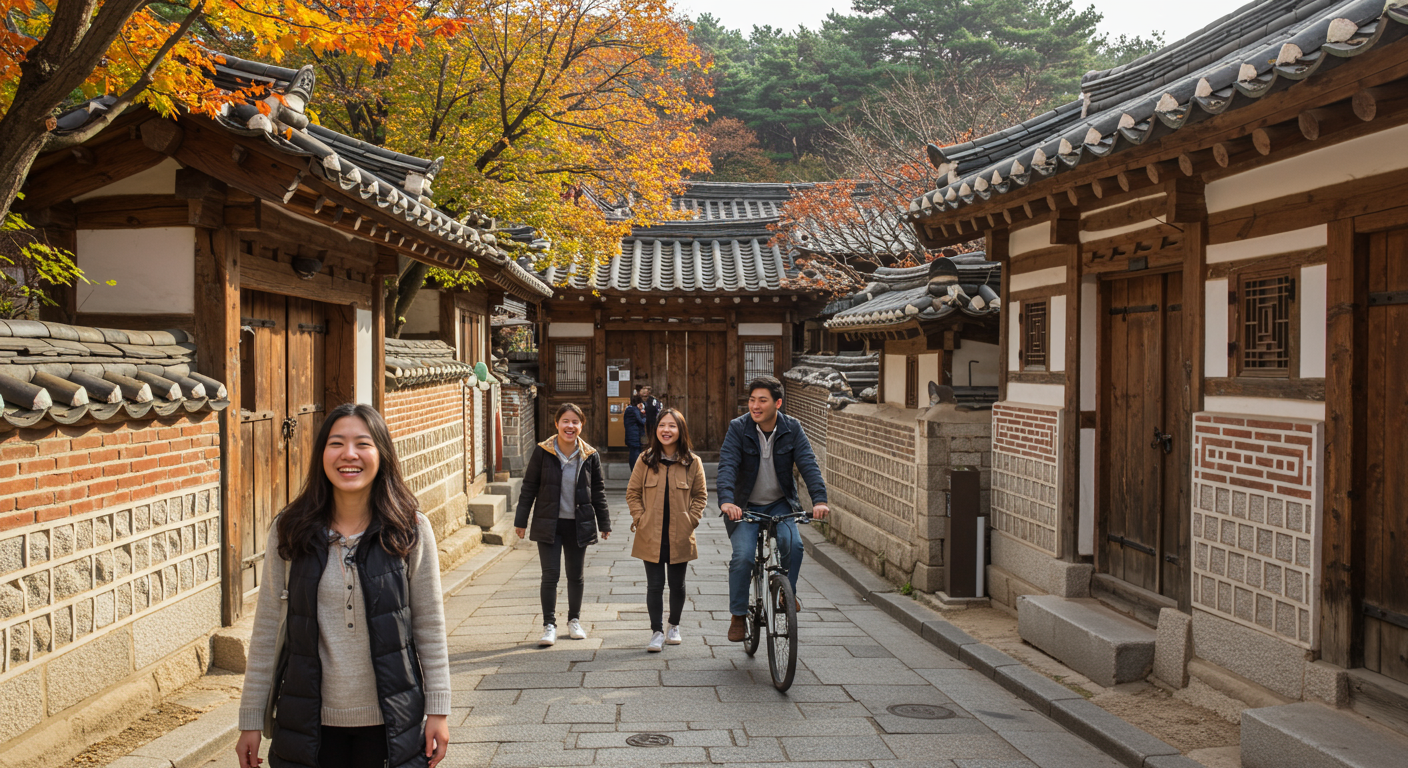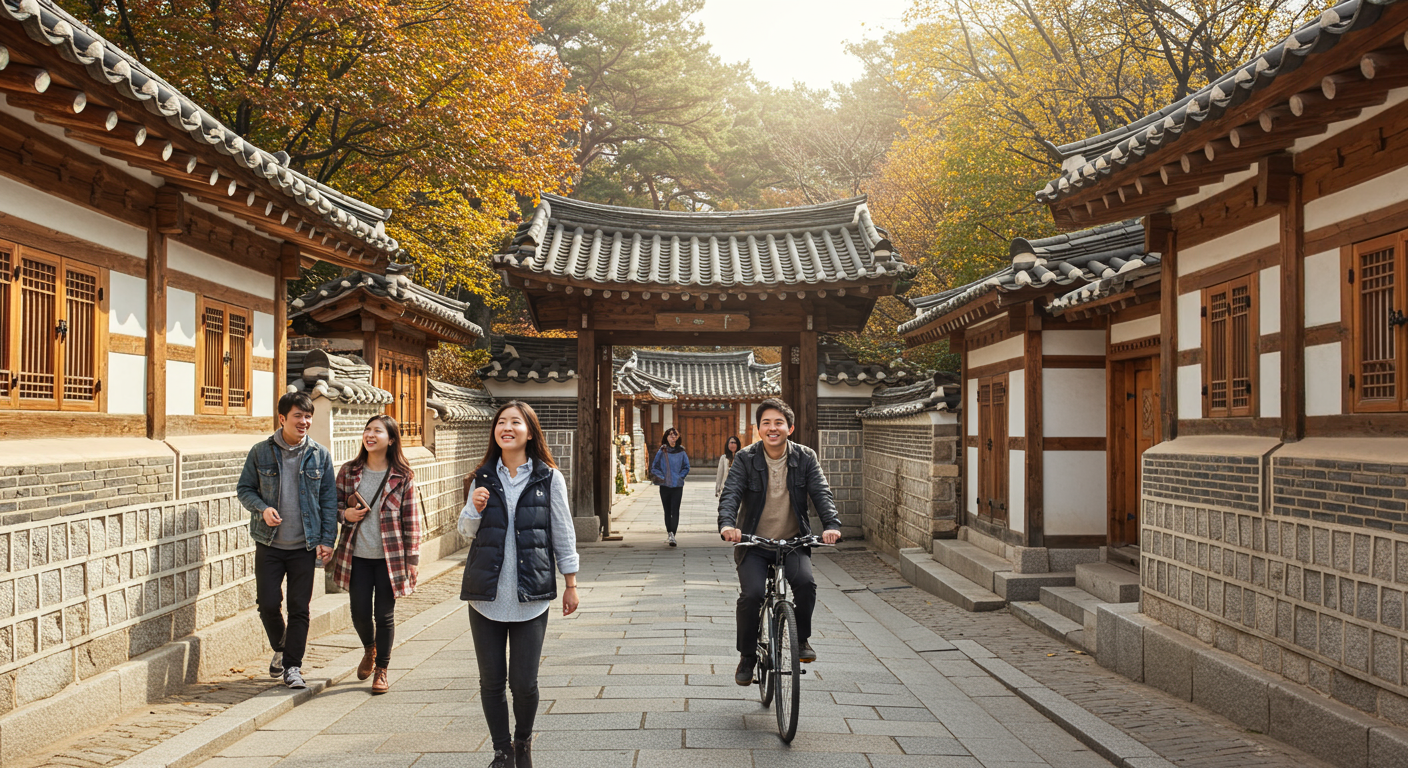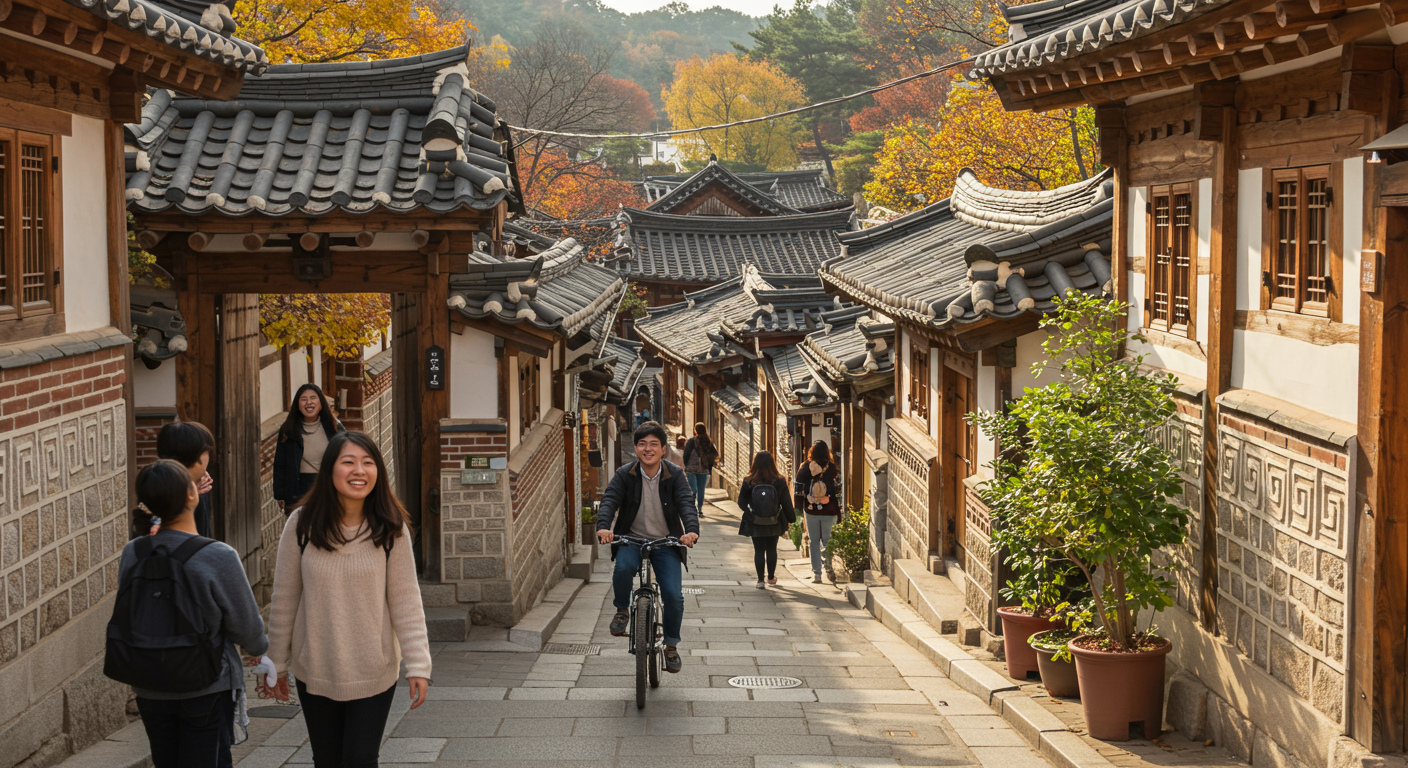Ikseondong Hanok Village: Unveiling Seoul's Hidden Charm in 2016
Ikseondong Hanok Village: Unveiling Seoul's Hidden Charm in 2016
Ever felt that rush of discovering a truly unique, untouched gem before everyone else does?
Back in 2016, I stumbled upon a place in Seoul that felt exactly like that: Ikseondong Hanok Village. It wasn’t yet the bustling hotspot it is today; it was a quiet, almost secret haven where the past and present danced in a delicate, captivating rhythm. I remember feeling a genuine sense of pride, like I'd found a secret passage to another time. And honestly? I couldn't wait to tell everyone about its undeniable coolness. Join me as I rewind to that unforgettable first visit.
 Description: "A young woman, perhaps me, standing at the entrance of Ikseondong Hanok Village in 2016, looking excited and curious. Traditional hanok buildings with modern cafes peeking through in the background, under a bright autumn sky. Realistic photo style."
Description: "A young woman, perhaps me, standing at the entrance of Ikseondong Hanok Village in 2016, looking excited and curious. Traditional hanok buildings with modern cafes peeking through in the background, under a bright autumn sky. Realistic photo style."
Table of Contents
The Allure of Ikseondong in 2016: A Glimpse into the Past
I remember walking through Jongno in 2016, looking for something... different. Everyone talked about Bukchon, sure, but it felt a bit too polished, too much like a museum exhibit. I wanted something more authentic, something with a bit more grit and a living soul. That's when a local friend, who's always got the inside scoop, whispered about Ikseondong. "It's just starting to get cool," she said, with a conspiratorial wink. And oh boy, was she right.
What really struck me was how it effortlessly blended the old world charm of Hanok (traditional Korean houses) with a subtle, emerging modern aesthetic. It wasn't trying too hard, you know? It just... existed, beautifully. It was the kind of place that made you feel like you'd stepped into a time capsule, yet still offered a fantastic cup of coffee.
What Made Ikseondong Different Back Then?
Honestly, in 2016, Ikseondong was a quiet residential area that was just beginning its transformation. There weren't many people. The main difference? The lack of overwhelming crowds. You could actually wander the narrow alleys without bumping into a dozen selfie sticks. The cafes and shops were fewer, each with a distinct, often quirky personality. It felt curated, almost intimate.
Here's a quick comparison of Ikseondong then vs. now, just to show you what I mean:
| Aspect | Ikseondong in 2016 | Ikseondong Today (Comparison) |
|---|---|---|
| Crowd Level | Light, mostly locals and curious explorers | Heavy, major tourist destination |
| Number of Shops/Cafes | Fewer, more niche and experimental | Numerous, wide variety, some chain-like |
| Atmosphere | Tranquil, artistic, discovery-focused | Lively, bustling, commercialized |
 Description: "A quiet, narrow alleyway in Ikseondong Hanok Village in 2016, with sunlight streaming through, highlighting the intricate wooden details of hanok eaves. A lone cyclist passes by, giving a sense of calm. Serene, slightly nostalgic photo style."
Description: "A quiet, narrow alleyway in Ikseondong Hanok Village in 2016, with sunlight streaming through, highlighting the intricate wooden details of hanok eaves. A lone cyclist passes by, giving a sense of calm. Serene, slightly nostalgic photo style."
My Favorite Spots and Hidden Alleys
I remember vividly wandering those tiny, winding alleyways. Each turn felt like a new discovery. There was this one cafe, I can't quite recall the name now, but it had a small, secluded courtyard with a persimmon tree. You know, the kind of place where you could spend hours just reading a book, sipping a strong americano and feeling utterly content. It was those "hidden alley" moments that truly defined Ikseondong for me in 2016.
- The Hanok Charm
- The traditional architecture was largely preserved, but with a modern twist. Exposed wooden beams, intricate tiled roofs, and small courtyards. It wasn't forced; it felt organic.
- Cozy Cafes
- Each cafe had its own personality, often converting old hanoks into stylish, yet traditional, spaces. Think mismatched antique furniture, jazz music, and artisan coffee.
- Unique Boutiques
- Small, independent shops selling handcrafted goods, vintage clothes, or unique artworks. Not the mass-produced stuff you see everywhere else.
The Vibe: Tradition Meets Trendy (Before the Crowds)
The vibe was just... perfect. It had this subtle coolness that wasn't trying to be cool. It was like an old soul with a fresh perspective. You could feel the history in the air, the scent of aged wood mixed with the aroma of freshly brewed coffee. It wasn't the kind of place where you had to wait in line for everything. You could just breathe.
What I loved about that early Ikseondong:
- Authentic Transformation: The hanoks weren't just facades; they were genuinely repurposed, maintaining their original structure while adding modern comforts.
- Community Feel: You could often see residents going about their daily lives, adding to the genuine, lived-in atmosphere.
- Artistic Flair: Small galleries, street art, and quirky decor were part of the charm, not an afterthought.
 Description: "An aerial view showing a cluster of beautifully preserved hanok rooftops in Ikseondong, interspersed with modern cafe signs and vibrant potted plants. The scene is bustling with a few people, but not overcrowded, reflecting the 2016 atmosphere. Lively illustration style."
Description: "An aerial view showing a cluster of beautifully preserved hanok rooftops in Ikseondong, interspersed with modern cafe signs and vibrant potted plants. The scene is bustling with a few people, but not overcrowded, reflecting the 2016 atmosphere. Lively illustration style."
Experiencing Ikseondong: Tips for a Nostalgic Visit (Even Today)
Even though Ikseondong has changed, you can still catch glimpses of that 2016 magic if you know how to look. It’s all about timing and perspective, I guess. If you want to relive a bit of my experience, here's what I recommend:
- Go early in the morning, right when shops are just opening. The streets are quieter, and you can still appreciate the architecture.
- Seek out the smaller, less obvious cafes. Avoid the main thoroughfares, and you might just find your own secret courtyard.
- Look up! The hanok roofs and eaves are beautiful. You'll notice details that are easy to miss in a hurry.
- Don't just eat and drink. Explore the little craft shops. Support the independent artists and creators. That's the real spirit of Ikseondong.
"Sometimes, the best way to experience a place is to let yourself get a little lost. That's when the real magic happens."
The Evolution: How Ikseondong Changed Since My First Visit
It’s inevitable, I suppose. When a place is truly special, people will find it. Ikseondong’s charm couldn't stay a secret forever. Over the years, it transformed from a hidden gem to a full-blown tourist destination. While it still retains its hanok architecture, the atmosphere is definitely more bustling, more commercial. New shops and cafes have popped up, some fantastic, some... well, a bit generic, if I'm being honest.
It makes me a little nostalgic for those quiet, empty alleys of 2016. But hey, it's still a beautiful place, and it's great that more people get to experience its unique character. It's just a different kind of experience now. And that's okay, I guess. Progress, right?
 Description: "Me, sitting at a cozy, slightly rustic cafe inside a renovated hanok in Ikseondong, 2016. A cup of coffee and a local pastry are on the wooden table. I'm smiling, enjoying the moment, looking out at the alley through a traditional window frame. Warm, inviting photo style."
Description: "Me, sitting at a cozy, slightly rustic cafe inside a renovated hanok in Ikseondong, 2016. A cup of coffee and a local pastry are on the wooden table. I'm smiling, enjoying the moment, looking out at the alley through a traditional window frame. Warm, inviting photo style."
Want to discover more hidden gems in Seoul? Sign up for our newsletter to get exclusive tips!
Frequently Asked Questions About Ikseondong Hanok Village
Absolutely! While it's changed, it still offers a charming blend of traditional Korean architecture and trendy modern establishments. It's a fantastic spot for unique cafes, eateries, and shops. Just manage your expectations regarding crowds, especially on weekends, and try visiting during off-peak hours.
You'll find a delightful array of independent boutiques selling handcrafted accessories, vintage clothing, unique stationery, and artisanal goods. There are also numerous cafes with distinct themes, traditional Korean restaurants (many with a modern twist), and even some retro game arcades or photo studios. It's quite diverse!
Ikseondong is often considered more trendy and youthful compared to Bukchon, which is more residential and grand, and Seochon, which has a more bohemian, artistic vibe. Ikseondong's hanoks are generally smaller and more densely packed, giving it a labyrinthine feel. Its commercial offerings are also more focused on unique dining and shopping experiences within the hanok structures themselves.
The easiest way is by subway. Take Line 1, 3, or 5 to Jongno 3-ga Station. Ikseondong is right next to Exit 4, 5, or 6. It's incredibly convenient and well-connected to other major tourist areas in Seoul.
Comments
Post a Comment